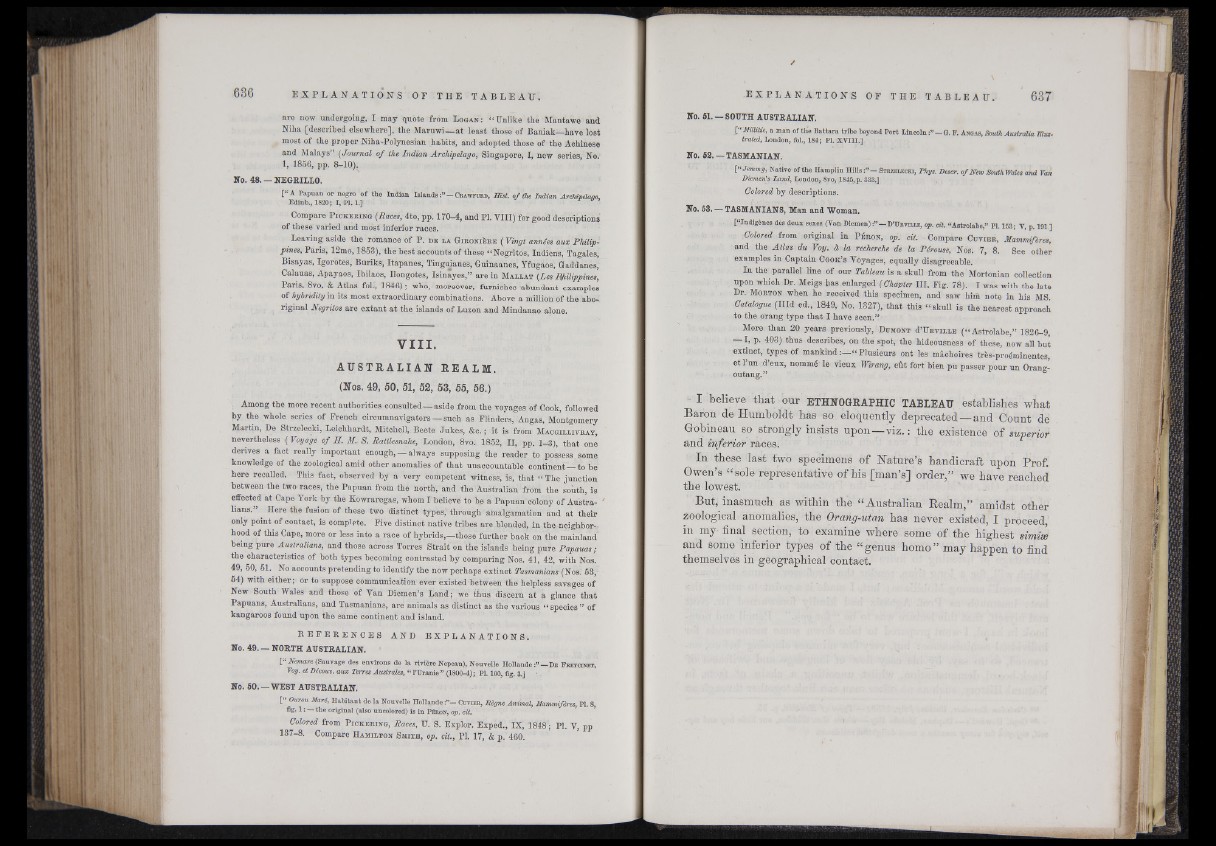
are now undergoing, I may quote from Logan: “ Unlike the Mantawe and
Niha [described elsewhere], the Maruwi— at least those of Baniak—hare lost
most of the proper Niha-Polynesian habits, and adopted those of the Aehinese
and Malays” ( Journal of the Indian Archipelago, Singapore, I, new series, No.
1, 1856, pp. 8-1Q),
No. 48. — NEGRILLO.
[“ A Papuan or negro of the Indian Islands ¿’—Crawtoed, Hist, o f the Indian Archipdaao.
Edinb., 1820; ■HM JO rJ Ml : ■ H .
Compare P ic k e r in g {Races, 4to, pp. 170-4, and Pl. VIII) for good descriptions
of these varied and most inferior races.
Leaving aside the romance of P. de la Giron iîSre {Vingt années aux Philippines,
Paris, 12mo, 1853), the best accounts of these “ Negritos, Indiens, Tagales,
Bisayas, Igorotes, Buriks, Itapanes, Tinguianes, G-uinaanes, Yfugaos, Gaddanes,1
Calañas, Apayaos, Ibilaos, Uongotes, Isinayes,” are in Mallat (Les Philippines,
Paris, 8vo, & Atlas fol.-, 1846) ; who, moreover, furnishes abundant examples
of hybridity in its most extraordinary combinations. Above a million of the abo-,
riginal Negritos are extant at the islands of Luzon and Mindanao alone.
VI I I .
A U S TR A LI A N REALM.
(Nos. 49, 50, 51, 52, 53, 55, 56.)
Among the more recent authorities consulted— aside from the voyages of Cook, followed
by the whole series of French circumnavigators— such as Flinders, Angas, Montgomery
Martin, De Strzelecki, Leichhardt, Mitchell,, Beete Jukes, &c. ; it is from Macgillivray,
nevertheless ( Voyage of H. M. S. Rattlesnake, London, 8vo. 1852, II, pp. 1-3), that one
derives a fact really important enough, — always supposing the reader to possess,some
knowledge of the zoological amid other anomalies of that unaccountable continent—to be
here recalled. This fact, observed by a very competent witness, is, that “ The junction
between the two races, the Papuan from the north, and the Australian from the south, is
effected at Cape York by the Kowraregas, whom I believe to be a Papuan colony of Au'stra- '
lians. Here the fusion of these two distinct types,'through amalgamation and at their
only point of contact, is complete. Five distinct native tribes are blended, in the neighbor-,
hood of this Cape, more or less into a race of hybrids,—those further back on the mainland
being pure Australians, and those across Torres Strait on the islands being pure Papauas;
the characteristics of both types becoming contrasted by comparing Ños. 41, 42, with Nos.
49, 50, 51. No accounts pretending to identify the now perhaps extinct Tasmanians (Nos. 58,
54) with either; or to suppose communication ever existed between the helpless savages of
New South Walès and those of Van Diemen’s Land; we thus discern at a glance that
Papuans, Australians, and Tasmanians, are animals as distinct as the various “ species” of
kangaroos found upon the same oontinent and island.
R E F E R E N C E S AND E X P L A N A T I O N S .
No. 49. — NORTH AUSTRALIAN.
[“ Nemare (Sauvage dea environs de la rivière Nepean), Nouvelle Hollande :” —Db Freycinet,
Voy. et Découv. aux Terres Australes, “ PUranie” (1800-4); Pl. 100, fig. 3.J
No. 50.—WEST AUSTRALIAN.
[“ Ourou Maré, Habitant de la Nouvelle Hollande C u v ie r , Règne Animal, Mammifères, Pl. 8,
fig. 1 : the original (also uncolored) is in P é r o n , op. cit.
Colored from Pickering, Races, U. S. Explor. Exped., IX, 1848; Pl. V, pp
137-8. Compare Hamilton Smith, op. cit., PI. 17, & p. 460.
No. 51. — SOUTH AUSTRALIAN.
[“Mlitir., a man of the Battara tribe beyond Port Lincoln:”—«. F. A n o a s , South Australia mus•
trated, London, fol., 184; Pl. XVIH.]
No. 52. —TASMANIAN.
[“Jemmy, Native of the Hamplin Hills S t r z e l e c k i , Fhys. Descr. o f New South Wales and Van
Diemenys Land, London, 8vo, 1845, p. 333.J
Colored by descriptions.
No. 53. — TASMANIANS, Man and Woman.
.[• Indigènes dès deux sexes, (Van Diemen) —D ’U r v il l e , op. cit. “Astrolabe,” PL 153 ; V, p. 191 ]
. :Colored from original in P é r o n , op. cit. Compare C u v ie r , Mammifères,
and the Atlas du Voy. à la recherche de la Pirouse, Nos. 7, 8. See other
examples in Captain C o o k ’s Voyages, equally disagreeable.
In the parallel line of our Tableau is a skull from the Mortonian collection
upon which Dr. Meigs has enlarged (Chapter III, Fig. 78). I was with the late
Dr. Morton when ho received this specimen, and saw h i* noté in his MS
Catalogue (Hid cd., 1849, No. 1327), that this “ skull is the nearest approach
to the orang type that I have seen.” "
More than 20 years previonsly, Dumont d’UnviLiiE (“ Astrolabe,” 1826-9,
— I, p. 403) thus describes, on the spot, the hideonsnéss of these, now all but
extinct, types of mankind :—“ Plusieurs ont les mâchoires très-proéminentes,
et l’un d’eux, nommé" le vieux Wirang, eût fort bien pn passer pour un Orang-
; outang.”
- I believe that our ETHNOGRAPHIC TABLEAU establishes what
Baron de Humboldt has so eloquently deprecated—and Count de
Gobineau so strongly insists upon—viz. ; the existence of superior
and inferior races. ' .
In these last two specimens of Nature’s handicraft upon Prof.
Gwen’s “ sole representative of his [man’s] order,” we have reached
the lowest.
But, inasmuch as within the “Australian Realm,” amidst other
zoological anomalies, the Orang-utan has never existed, I proceed
in my final section, to examine where some of the highest simiæ
and some inferior types of the “ genus homo” may happen to find
themselves in geographical contact.